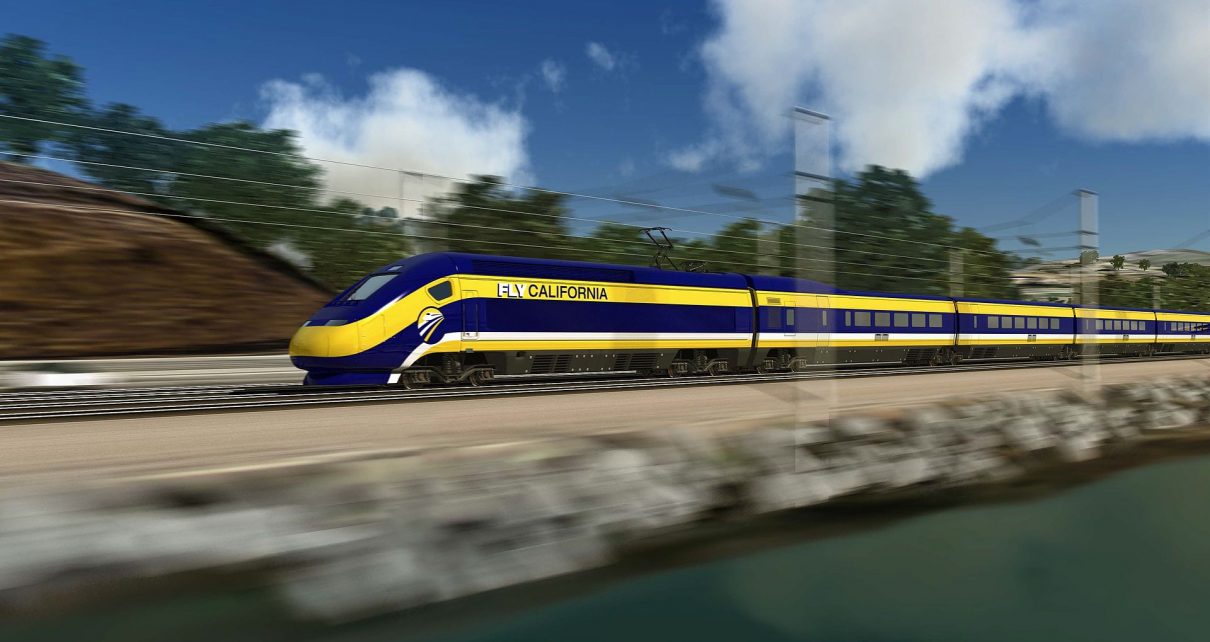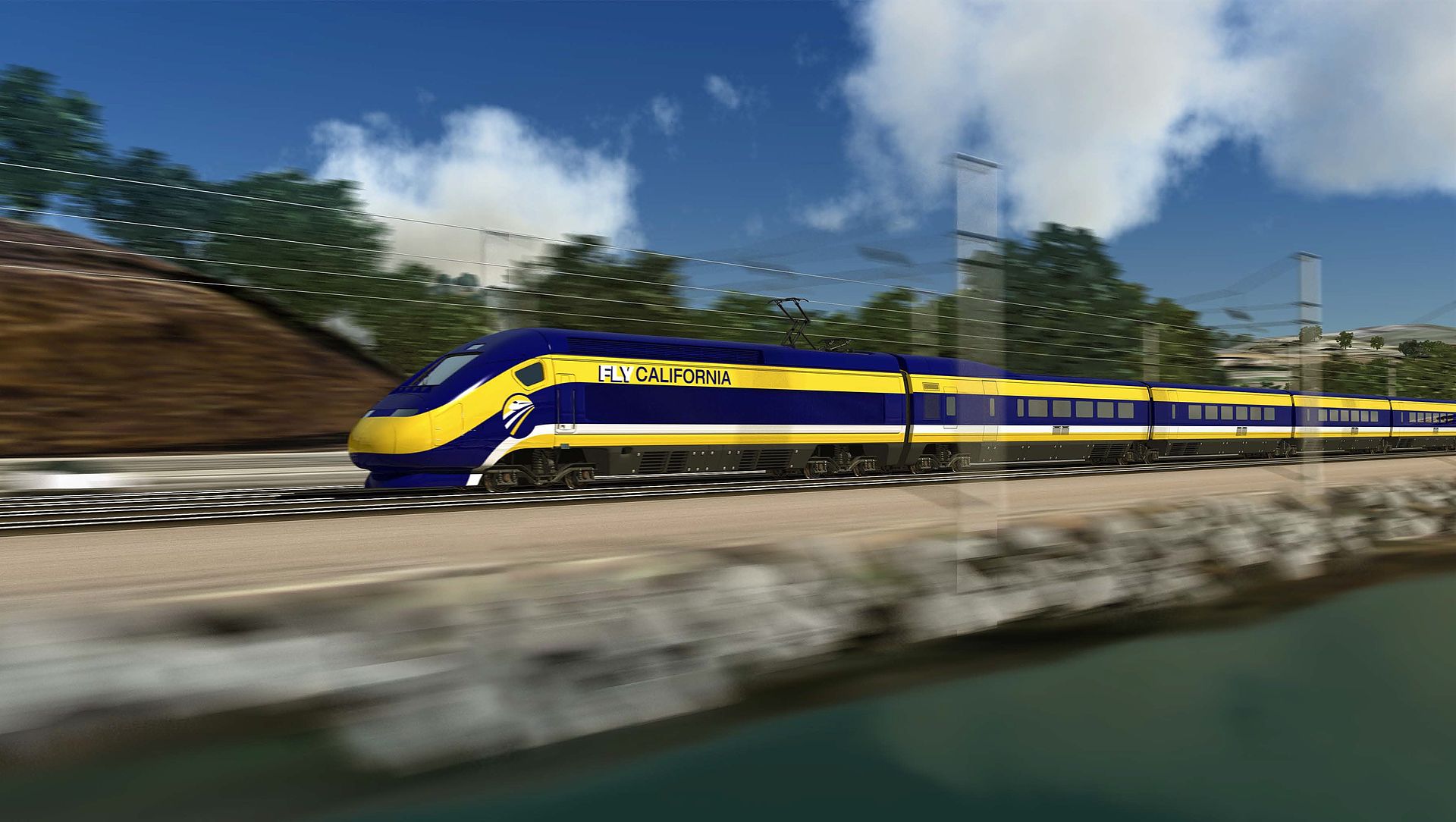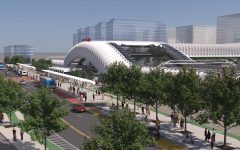
High Speed Rail train, artists rendering. (Photo: CHSRA.ca.gov)
High Stealth Rail: Where Did the Rest of It Go?
It’s an addict’s plan, no different than the lies and schemes spouted and conjured by people desperate to find money for their next fix
By Thomas Buckley, March 31, 2024 2:47 am
In 2008 voters passed Proposition 1A, directing the California High-Speed Rail Authority (Authority) to construct an electrified 494-mile-long rail system connecting the mega regions of Los Angeles and San Francisco to the growing cities of the Central Valley.
This is the first sentence of the first chapter of the 2024 California High Speed Rail Authority (CHSRA) business plan and it is wrong, it is intentionally misleading, and it is a sadly typical example of the on-going grift at the heart of the project.
California voters did no such thing – California voters voted to approve an 800 mile system that would go from San Diego to Sacramento. It’s in writing – it’s in the text of the proposition:
“…by approving the bond measure pursuant to this chapter to initiate the construction of a high-speed train system that connects the San Francisco Transbay Terminal to Los Angeles Union Station and Anaheim, and links the state’s major population centers, including Sacramento, the San Francisco Bay Area, the Central Valley, Los Angeles, the Inland Empire, Orange County, and San Diego.”
That entire system was projected to cost $40 billion – the bond was for the $9.95 billion – and was supposed to be done four years ago.
Now, it is projected to cost about $130 billion for the LA to SF part alone and be actually completely done by, well, that’s not even projected anymore in the business plan because – except for a couple of maps – the sections to Sacramento and San Diego are not being mentioned any more.
At all. In fact, the only non-map use of the word “Sacramento” in the entire document is when it appears in the Authority’s address.
It is true that technically the text of the proposition does mention La to SF as “phase 1” but that is merely for planning purposes – not for “being done” purposes. Just in case you were not entirely convinced that the Authority has junked the statewide idea, here’s another quote from the plan:
“While construction and early operations primarily focus on the Central Valley, the success of the larger 494-mile statewide project relies on the progress made throughout the entire state. These efforts collectively contribute to the achievement of the project’s objectives, as approved by California voters.”
This latest business plan – like previous plans but a tad more noticeable this time – seems to have the authority just giving up on the idea of ever actually finishing the project.
From the beginning, the plan was clearly overly optimistic, optimistic to the point of delusional. Or intentionally overly optimistic to convince enough voters from places it knew it would never actually serve, like San Diego and the Inland Empire, to say yes. If those votes are taken out of the 2008 count, the entire project almost certainly fails to pass.
Now the Authority seems to be confident enough that it doesn’t even have to bother to pretend it will ever be done.
Every “business plan” from its inception has seen the project get smaller, take longer, and get more expensive. At this point, the plan could be considered reasonable if it said the project will cost 47,000 quatloos and be done next Grunsday – it’s all unsupportable meaningless drivel meant to keep the money flowing.
It’s an addict’s plan, no different than the lies and schemes spouted and conjured by people desperate to find money for their next fix.
And what did the addict promise at the beginning, what was the expected return on the “if you just give me this, everything will be fine and I won’t ask again and you’ll see how great it will work out.”
That’s easy to answer because they are still all online, never to be lost or forgotten here, and here.
117 million passengers a year, a billion in annual profit, federal funding of about $14 billion needed, public-private partnerships on tap to cover the rest, no more money from state coffers, 450,000 new permanent jobs, 160,000 construction jobs, and on and on.
Now, the business plan estimates construction has created 92,000 “job years.” It’s been going on for 16 years, so that’s about 6,000 permanent jobs, 1.3% of the promised amount (or about 5% if you just go by construction jobs.)
The new plan estimates about one-third of the original ridership figure, but still somehow manages to project a profit – actually, that number has gone up somehow.
Another original selling point is that would be half the cost of building roads and runways and such to move the same number of people around our ever-growing ever-prosperous state. The irony of the following claim is impossible to miss:
“To serve the same number of travelers as the high-speed train system, California would have to build nearly 3,000 miles of new freeway plus five airport runways and 90 departure gates in the next two decades. With a price tag of $82 billion, such levels of construction are barely plausible.”
Barely plausible is right. But the Authority still maintains that since those road and air infrastructure costs would now come in at $211 billion, high speed rail is still cheaper.
Of course, a description/discussion of the actual need for any of those improvements, particularly in light of California’s population dipping or holding steady at best, cannot be found in the plan.
Barely plausible, indeed.
As to the specifics of this year’s plan, it places the cost of Bakersfield to Merced at $35 billion dollars – much of that already spent between Shafter and Madera. Another $35 billion or so to get into San Francisco and another $52-ish billion to get from Bakersfield to La/Anaheim via Palmdale. By the way, the route between Palmdale and Burbank is now expected to be “mostly tunnels” and take only 13 minutes to travel.
The report glancingly mentions the much-touted concept floated in 2022 to have the system generate its own power via solar panels on land the Authority controls. For Bakersfield to Merced, the cost of that is $230 million dollars. The plan also mentions another $200 million for the “solar scope” of the LA/SF extensions. Those numbers are impossibly low, which, one assumes, is why the “solar sustainability” aspect of the project was mentioned, again, glancingly.
By 2030, the report says, the train will be running through the Central Valley and carrying millions of people and turning a profit. Those estimates are what is called “valley to valley” in the report, i.e. from San Franciso to Bakersfield, not merely to/from Merced or Madera.
The Authority claims that about 12 million people will ride it every year “(W)hen the project is extended into Northern California and the Silicon Valley from the Central Valley … roughly the equivalent of the current Northeast Corridor intercity service on the East Coast,” and that when it goes from LA to SF it will carry two and half times the number of people who take the train in the Boston-NYC-DC megalopolis.
That’s wrong – no other way to describe it. 55 million people live there, at least double the number between and including LA and San Fran, and it is far more densely populated and far more larger cities between the two ends of the system. In the past, comparisons to Japan’s high speed system have been just as deceptively floated.
The plan also calls for the state’s “cap and trade” program be extended to 2050 with a billion each year going to the project and for a way to figure out a more regular, reliable, steady, and bigger flow of direct state money to the project, even though that is expressly forbidden by the proposition.
But the Authority has a plan to get around that, and it’s a plan based on hard data and sober projections and ethical considerations: the state’s Rainy Day Fund.
Get this:
“Make high speed rail a priority for “Rainy Day” Infrastructure Funds. Proposition 2 Budget Stabilization Account (Rainy Day Fund) of the State Constitution requires that certain funds be directed to infrastructure investments when the Rainy Day Fund is at the constitutional maximum of 10 percent of General Fund revenues. When this mechanism is triggered, directing these funds to the Authority would advance additional segments to construction.
Beyond constitutionally mandated Rainy Day Fund, other General Funds were directed to Transportation Infrastructure in 2022 and 2023 Budget Acts — but none of these funds went to high-speed rail. When the state budget again returns to years of budget surpluses, the high-speed rail project is an appropriate use of surplus state funds that would not create new ongoing funding commitments of General Fund dollars.”
Barely legal and laughably absurd, but it’s part of the plan.
Come to think of, barely legal and laughably absurd pretty much covers the whole thing.
In case you are interested, here’s the plan itself: https://hsr.ca.gov/wp-content/uploads/2024/02/2024-Draft-Business-Plan-020724-A11Y.pdf
And here’s the text of the proposition: https://www.lalawlibrary.org/pdfs/PROP_1108_1A.pdf
The plan will be discussed by the Authority board on April 11 (it doesn’t appear the physical location has yet to be set but it will be in Sacramento.). You can submit a comment by filling out this form https://hsr.ca.gov/2024-draft-business-plan-comment-form/ or you can email businessplan2024@hsr.ca.gov before April 9.
And in case you want to contact Authority board members you can do so here: Board of Directors Secretary (916) 324-1541 boardmembers@hsr.ca.gov
- Abort Last Week: Gov. Newsom Actually Promoting Abortion - April 29, 2024
- ADA Diana Teran Booked, Los Angeles DA Gascon Faces Another Complaint - April 28, 2024
- Curiouser and Curiouser: Gascon’s Aide Charges Raise Troubling Issues - April 27, 2024




“It’s an addict’s plan, no different than the lies and schemes spouted and conjured by people desperate to find money for their next fix.”
That’s what it is, all right. No kidding. These out-of-control permanent adolescents have made such a mess THEY probably don’t even know how much is in their slush fund. Nor can the adults in the room —- if there are any left —- even BEGIN to figure out how to clean the mess up. The least the juvenile delinquents could do is dump the whole thing —- NOW —- but even that seems unlikely to happen.
“Now the Authority seems to be confident enough that it doesn’t even have to bother to pretend it will ever be done.”
Exactly. And that’s because the Dem/Marxist mental patients in charge have been shooting up in public for so long and getting away with it they think it’s all good and perfectly fine. Even THEY don’t think that this vote-buying, union-gifting, out-of-control jobs program of a slush fund of a boondoggle is a problem anymore at all, or could even be perceived by anyone as a problem.
Can we at least hope that what’s happened here will somehow be a lesson to people who thought it would be cute to vote for preposterous projects like this? You know, projects that never made sense and which had no viable plan from the beginning?
I hear the train will be so fast that when completed it will warp time and space and actually end up being done four years ago. Not only will it produce a billion dollars of profit every year it will cause passengers to lose 10 pounds, grow an inch in height and age backwards 1 year for each trip.
HA HA!
Is there anyone with enough interest to start an initiative to cancel the project? Any legislators supportive? The money would be enough to bail out the state deficit.
How is this not fraud?
If a contractor jacked you around like this on a kitchen remodel job, he’d be doing hard time in The Joint. Everyone who had a hand in this – and took home so much as one dollar – needs to be locked up.
Agree with you.
Good point. This project is nothing but corruption on display.
Don’t forget about the hundreds of state employees that work for the California High-Speed Rail Authority. Tax payers foot the bill for their medical/dental and pay their pensions upon retirement. This grift isn’t going anywhere and is here to stay.
Actually their “statewide high speed rail plan” is working perfectly even though it hasn’t been built. It’s like a thousand other things…
Never is any explanation ever given (or demanded).
There are no hearings.
No politician speaks out.
No state employee is fired, transferred or penalized
No secret grand jury
No whistleblowers make headlines
No front page stories in major newspapers
No TV investigative reporters expose anything
No State Attorney General ever investigates.
Perfect.
I attended one of the first meetings they had, inviting companies to bid on various parts of the project (I own an environmenta consulting company). However, I detected a very bad smell at that meeting, so decided to stay far away from it. The excellent book Risk mentions this mess, focusing on how they had no idea how they would get through the mountains.
Paraphrasing George Orwell regarding war,
“Government construction projects are not mean to be completed. They are meant to be continuous.”
Until Californians (and the rest of the USA) develop some common sense, boondoggles like this will continue. Those who voted for this were uninformed and didn’t have the common sense to think about the claims, which were then, and still are, dreams that will never come true.
This isn’t much different than the fear mongering done when the “pandemic” struck; millions of Americans were going to die! Anyone who was using their brain knew that that prediction was wildly unfounded. Unfortunately, those that did use their brain were a minority of the population, and the others just blindly followed along with whatever our “leaders” told them to do. It will happen again unless people use the brains God gave them!!